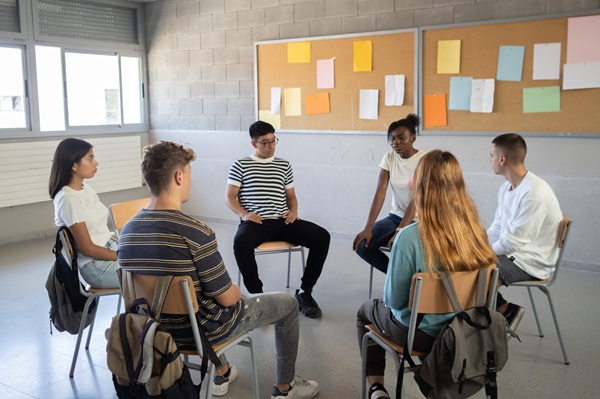Building community through dialogue, not punishment

Restorative practices can make a difference in schools, and provide an escape from the paradigm of guilt and punishment. They focus on building and strengthening relationships and community, and taking responsibility when someone or something has been harmed.
Rather than asking what rule has been broken, who is to blame and what punishment should be imposed, we ask which relationships have been violated and what form of repair those involved need. This approach promotes connection, giving space to what sustains the community and ensuring that everyone’s perspectives are seen and heard.
Thanks to funding from the federal ‘Live Democracy!’ programme, we were able to work with restorative practices using a whole-school approach for the first time in Germany. I would like to share three lessons we learned.
Adults as the target group
Children learn by observing and imitating adults, so the pilot project’s target group was staff at an elementary school. Inviting adults to school to take on the role of learners can lead to resistance, so we had to repeatedly make clear that the initial aim of our work was not only to change the children’s behaviour. Interventions that only focus on children can result in adults teaching them things that we do not model in everyday life. A classic example is when an adult shouts: ‘Everyone be quiet!’ – the verbal message encourages speaking quietly, but its delivery sets an example that it is okay to shout in order to be heard.
Whole-school change process with a steering group
Restorative practices represent a cultural change, as most of us grew up in cultural settings and school structures with a focus on guilt and punishment. Therefore, the pilot project was designed as a process of whole-school change. The steering group, which comprised school staff (management, teachers, social workers) and project staff, played a central role. It met monthly to discuss next steps and ensure that the project’s measures met the needs of the school.
Continuous collaboration created trusting relationships, so activities could be discussed honestly and openly. The school-based members will continue their work beyond the end of the project, so the steering group is an important element of the sustainability of the project measures.
Unfortunately, it was only towards the end of the project that a member from the professional group of educators joined the steering group, and it was not possible to recruit someone from the school secretariat or building management to incorporate their perspective.
Using circles in a proactive and reactive way
We organised all our meetings and workshops in the spirit of the circle – circle meetings are a central element of restorative practice. The power of the circle meeting is in its structure (checking in and out, using a ‘talking piece’) and in its leading mindset (everyone can contribute and feel a sense of belonging). This structure and mindset also help us to react well to incidents and conflicts.
In a Year 5 class, a post about child pornography was discussed in the class council. The focus was not on accusations and blaming, but on how it affected group members and their relationships. Using a talking piece, both pupils and teacher were able to share their perspectives without being interrupted. The check-out question (‘When have you ever done something that you only understood the full extent of afterwards?’) focused on shared experiences to prevent the child responsible from being excluded. After the restorative class council, everyone was able to concentrate on learning activities again.
The parents’ evening, which took place shortly afterwards in another circle, also allowed parents to put blame and one-sided demands aside. The parents realised that they wanted to have more contact with each other in order to be able to better support difficult classroom situations at home.
Conclusion
Feeling a sense of belonging, that one’s own perspective is heard and that it is possible to work through conflicts together beyond guilt and punishment are all strengthening factors for communities. They make it possible to experience democracy as a way of life.
Further reading
Additional information
-
Education type:School Education
-
Target audience:TeacherStudent TeacherHead Teacher / PrincipalSchool PsychologistTeacher EducatorResearcher
-
Target audience ISCED:Primary education (ISCED 1)Lower secondary education (ISCED 2)

